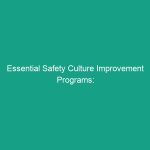Introduction
Good morning team! Today, we’re diving into a crucial topic that directly impacts our Safety and efficiency at work: Choosing the Right Tool for the Job & Avoiding Misuse. Understanding how to select the appropriate tools and use them correctly is vital not only for completing our tasks effectively but also for ensuring our Safety and the safety of our colleagues.
Why is this important? Using the wrong tool can lead to accidents, injuries, and even damage to equipment. By the end of this Toolbox Talk, you’ll have a clearer understanding of how to choose the right tools, recognize potential Hazards, and implement Safety Measures to avoid misuse.
Understanding Choosing the Right Tool for the Job
Choosing the right tool for the job means selecting the most suitable equipment or instrument needed to perform a specific task safely and efficiently. This process is essential in our daily operations, as using the wrong tool can lead to ineffective work, increased effort, and elevated risks of accidents.
Many employees may assume that all tools are interchangeable or that any tool can suffice for a job. However, this misconception can lead to serious safety issues. For example, using a screwdriver as a pry bar might seem convenient, but it can easily slip and cause injury. Understanding the right tool for the job ensures we minimize risks and enhance productivity.
Key Hazards, Risks, and Safety Considerations
When it comes to choosing tools, several hazards and risks can arise:
- Inappropriate Tool Selection: Using the wrong tool can lead to equipment failure and personal injury.
- Tool Misuse: Even the right tool can be dangerous if used incorrectly. For instance, using power tools without proper Training can result in serious accidents.
- Environmental Factors: Some tools may not be suited for specific environments, such as wet or hazardous conditions, increasing the risk of accidents.
Ignoring these safety protocols can have real-world consequences. For instance, an employee may suffer a laceration from a tool used improperly, resulting in downtime and potential long-term injuries. It’s crucial that we stay vigilant and prioritize safety in our tool selection and usage.
Best Practices, Procedures, & Actionable Advice
To ensure safety and efficiency, follow these Best Practices when selecting and using tools:
- Assess the Task: Understand the job requirements before selecting a tool. Are you cutting, drilling, or fastening? Each task requires specific tools designed for that purpose.
- Inspect Tools Regularly: Before using any tool, inspect it for wear and tear. Ensure that it is clean, functional, and safe to use.
- Receive Proper Training: Always seek training on how to use tools effectively and safely. Familiarize yourself with the operating manuals and Safety Guidelines.
- Use Personal Protective Equipment (PPE): Always wear appropriate PPE, such as gloves, goggles, or helmets, when operating tools.
Let’s look at a case study: In a recent incident, an employee used a wrench that was too large for a specific nut. Instead of using the correct tool, the employee strained their wrist, leading to a significant injury. This situation could have been avoided by simply selecting the proper-sized wrench.
Regulations, Standards, and Compliance
Compliance with safety Regulations is crucial for maintaining a safe work Environment. Relevant Standards include:
- OSHA Standards: The Occupational Safety and Health Administration provides guidelines on tool safety and training requirements.
- ISO Standards: The International Organization for Standardization sets quality and safety standards for tools used in various industries.
- Company-Specific Policies: Familiarize yourself with our company’s safety protocols and ensure you adhere to them.
Compliance is critical as it helps protect employees from unnecessary risks and ensures a safer workplace. Regular training sessions and updates on safety regulations are essential to keep everyone informed and compliant.
Employee Engagement & Discussion
Now that we’ve covered the importance of choosing the right tools and avoiding misuse, let’s engage in a discussion. Here are some questions to consider:
- What safety challenges have you encountered related to tool usage in your work?
- Can anyone share a time when using the correct tool made a significant difference in completing a task?
- How can we improve our tool selection and usage practices in our daily operations?
I encourage everyone to share their experiences and insights. Your feedback is invaluable in enhancing our safety practices.
Conclusion & Key Takeaways
In summary, choosing the right tool for the job is essential to our safety and efficiency. Always assess the task, inspect tools, receive proper training, and use PPE to minimize risks associated with tool usage. Remember, the right tool can make a significant difference in completing tasks effectively and safely.
Thank you all for your attention and commitment to safety. Let’s make it a priority to apply these practices every day at work. Stay safe, and let’s work together to maintain a healthy and secure workplace!


